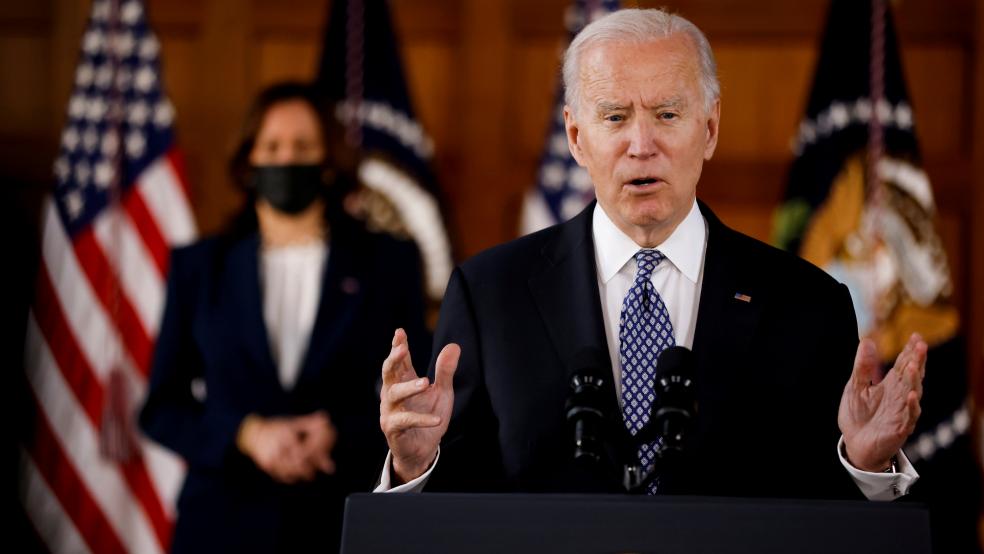President Joe Biden’s economic advisers are preparing a sweeping $3 trillion spending plan that would focus on jobs, infrastructure and climate change but also include a range of other policy priorities, according to reports Monday in The New York Times and The Washington Post.
The advisers reportedly are set to propose splitting the plan across two bills instead of pursuing one giant package, though the details — including the final cost — are still in flux and it is unclear whether Biden will sign off on that strategy.
The Times’s Jim Tankersley reports:
“The first legislative piece under discussion, which some Biden officials consider more appealing to Republicans, business leaders and many moderate Senate Democrats, would combine investments in manufacturing and advanced industries with what would be the most aggressive spending yet by the United States to reduce carbon emissions and combat climate change.
“It would spend heavily on infrastructure improvements, clean energy deployment and the development of other ‘high-growth industries of the future’ like 5G telecommunications. It includes money for rural broadband, advanced training for millions of workers and 1 million affordable and energy-efficient housing units. Documents suggest it will include nearly $1 trillion in spending alone on the construction of roads, bridges, rail lines, ports, electric vehicle charging stations and improvements to the electric grid and other parts of the power sector. …
“The second plan under discussion is focused on what many progressives call the nation’s human infrastructure — students, workers and people left on the sidelines of the job market — according to documents and people familiar with the discussions. It would spend heavily on education and on programs meant to increase the participation of women in the labor force, by helping them balance work and caregiving. It includes free community college, universal pre-K education, a national paid leave program and efforts to reduce child care costs.”
Questions about offsetting costs and legislative strategy: The expected $3 trillion in proposed spending does not include the cost of extending newly enacted temporary tax cuts aimed at fighting poverty and reducing inequality, meaning that the ultimate price tag could still grow by hundreds of billions of dollars.
As is always the case when it comes to infrastructure, how to pay for the proposed spending is sure to be a point of contention.
Biden administration officials reportedly have considered offsetting at least some of the infrastructure spending through tax hikes on corporations, but any such proposal is likely to be dismissed by Republicans. “I don’t think there’s going to be any enthusiasm on our side for a tax increase,” Senate Minority Leader Mitch McConnell (R-KY) said last week.
Biden and congressional Democrats may have to decide whether to try to forge a compromise with Republicans, and potentially scale back the corporate tax increases, or again look to use the budget reconciliation process that enabled them to pass the $1.9 trillion American Rescue Plan without any GOP support.
“Administration officials are considering offering to extend some 2017 tax breaks that are set to expire, like the ability to immediately deduct new investments, as part of their plans in order to win over business support,” Tankersley writes.
Administration officials reportedly are also considering options for offsetting the cost of making new tax cuts permanent through steps that would reduce other federal spending, such as allowing Medicare to negotiate drug prices, or by raising the top individual income tax rate from 37% back to 39.6% — and, perhaps, by lowering the threshold for that top rate for individuals from north of $500,000 to $400,000.
The Congressional Budget Office estimated last year that a Democratic bill to lower prescription drug costs could save the government about $450 billion over 10 years.
Why it matters: The Biden White House is again going big, but as the Post’s Jeff Stein and Tyler Pager write, there remains a divide among Democrats on what the administration should do next:
“Democrats’ left-flank is clamoring for the party to use its rare hold on power in Washington to approve long-held policy goals, from an expansion of health care to action on climate change. Democrats’ centrist wing, however, has expressed repeated unease about the party-line vote over pandemic relief, and has pushed for a return to bipartisan policymaking. That could complicate passage, particularly through the Senate, of any major Biden infrastructure package.”





